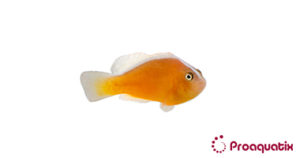
Orange Skunk (Amphiprion sandaracinos)
Description:
The Orange Skunk clownfish is pale orange with a single white stripe that runs down the dorsal ridge from the superior lip to the caudal peduncle.
Natural Ecology:
This species naturally lives among the tentacles Sebae anemones (Heteractis crispa) and Mertens’ carpet anemones (Stichodactyla mertensii). This natural behavior protects wild clownfish from predators. Proaquatix clownfish do not require anemone hosts but will accept them if present.
Indigenous To:
They are found in the Philippines, Indonesia, New Guinea, northwestern Australia, Christmas Island, Melanesia, and Ryukyu Islands of southern Japan.
Behavior:
Like all clownfish, Amphiprion sandaracinos is a sequential hermaphrodite. The largest individual present will exert dominance and become reproductively female. The next largest fish will become reproductively male. Other smaller individuals are rarely tolerated. Presence of the female significantly impedes the growth rate of the male.
Compatibility:
Usually ignores reef invertebrates and corals. Clownfish sometimes adopt various corals and algae as substitutes for host anemones.
Food:
Proaquatix specimens have been weaned to take aquarium pellets and flakes. Freshly frozen invertebrates such as ocean plankton, Mysis shrimp, and brine shrimp will be readily accepted.
